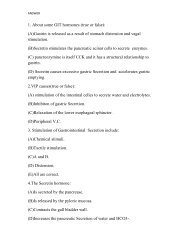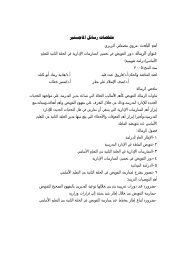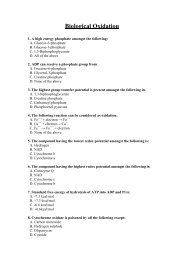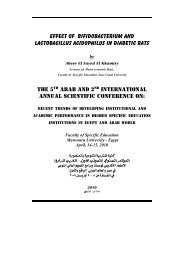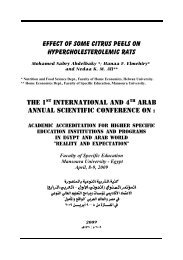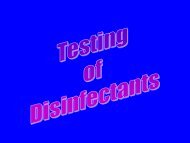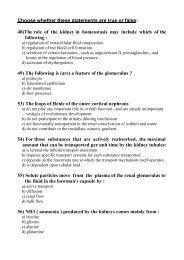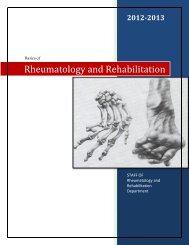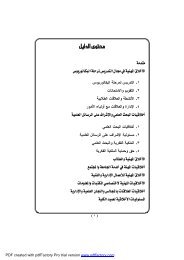CURRENT ISSUES REGARDING Helicobacter pylori
CURRENT ISSUES REGARDING Helicobacter pylori
CURRENT ISSUES REGARDING Helicobacter pylori
You also want an ePaper? Increase the reach of your titles
YUMPU automatically turns print PDFs into web optimized ePapers that Google loves.
<strong>CURRENT</strong> <strong>ISSUES</strong> <strong>REGARDING</strong><br />
<strong>Helicobacter</strong> <strong>pylori</strong> : From 1875 to<br />
Nobel prize 2005<br />
By<br />
SALAH EL GAMAL, M.D.<br />
PROFESSOR OF INTERNAL MEDICINE,<br />
Gastroenterology Unit<br />
MANSOURA UNIVERSITY
<strong>Helicobacter</strong> <strong>pylori</strong> is a Gram-negative bacterium<br />
that infects the lining of the stomach and duodenum .<br />
It is the the only known microorganisms that can<br />
thrive in the highly acidic environment of the stomach.<br />
Its helical shape (from which its name is derived) is<br />
thought to have evolved to penetrate and colonize the<br />
mucus lining (Samuel Baron ,.)<br />
1996
The stomach is protected from its own gastric<br />
juice by a thick layer of mucus that covers the<br />
stomach lining. Once H. <strong>pylori</strong> is safely<br />
ensconced in the mucus, it is able to fight the<br />
stomach acid that does reach it with an enzyme<br />
it possesses called urease tht converts urea, of<br />
which there is an abundant supply in the stomach<br />
(from saliva and gastric juices), into bicarbonate<br />
and ammonia, which are strong bases. This<br />
creates a cloud of acid neutralizing chemicals<br />
around the H. <strong>pylori</strong>, protecting it from the acid<br />
in the stomach. The reaction of urea hydrolysis is<br />
important for diagnosis of H.<strong>pylori</strong> by the breath<br />
test.
History of discovery
In 1875, German scientists found helical shaped bacteria<br />
in the lining of the human stomach. The bacteria could not<br />
be grown in culture and the results were eventually<br />
forgotten (Blaser, .) 2005<br />
The bacterium was rediscovered in 1979 by Australian<br />
pathologist Robin Warren, who did further research on it<br />
with Barry Marshall beginning in 1981; they isolated the<br />
organisms from mucosal specimens from human<br />
stomachs and were the first to successfully culture<br />
them(Marshall, 2006). In their original paper, Warren and Marshall<br />
contended that most stomach ulcers and gastritis were<br />
caused by infection by this bacterium and not by stress or<br />
spicy food as had been assumed before (Marshall and Warren, ) 1984
In 1985, Marshall drank a Petri dish of H. <strong>pylori</strong>, (1 million<br />
bacteria) developed gastritis, and the bacteria were<br />
recovered from his stomach lining, thereby satisfying<br />
three out of the four Koch's postulates. The fourth was<br />
satisfied after a second endoscopy ten days after<br />
inoculation revealed signs of gastritis and the presence of<br />
"H. <strong>pylori</strong>". Marshall was then able to treat himself using a<br />
fourteen day dual therapy with bismuth salts and<br />
metronidazole. Marshall and Warren went on to show that<br />
antibiotics are effective in the treatment of many cases of<br />
gastritis.<br />
In 2005, Warren and Marshall were awarded the Nobel<br />
Prize in Medicine for their work on H. <strong>pylori</strong>.
EPIDEMIOLOGY
In Western countries, H.<strong>pylori</strong> affects about 20%<br />
of persons below the age of 40 years, and 50% of<br />
those above the age of 60 years.<br />
-H.<strong>pylori</strong> is uncommon in young children.<br />
-Low socio-economic status predicts H.<strong>pylori</strong><br />
infection.<br />
-Immigration is responsible for isolated areas of<br />
high prevalence in some Western countries.<br />
In developing countries most adults are<br />
infected.<br />
H. <strong>pylori</strong> infection begins in early childhood,<br />
with up to 50% of children being infected<br />
before the age of ten, and 80–90% of the<br />
population being infected by adulthood(Naficy et<br />
al., 2000).
Epidemiological studies suggest person-to-person<br />
transmission, by either faecal-oral or oral-oral<br />
routes, to be the major mechanism. In developing<br />
countries, there is evidence for both food- and<br />
water-borne transmission of H. <strong>pylori</strong>.<br />
Intrafamilial spread appears to play a central role<br />
in transmission of the infection in both<br />
developing and developed countries (Sinha et al., 2004).<br />
Iatrogenic transmission can occur, in which<br />
tubes, endoscopes, or specimens in contact with<br />
the gastric mucosa from one person are<br />
introduced to another person (Akamatsu et al., 1996).<br />
Occupationally acquired infections<br />
(laboratorians) also have been reported (Sobala et al., 1991).
It was generally believed that following<br />
acquisition of H. <strong>pylori</strong>, and in the absence<br />
of treatment, infection would persist<br />
throughout life. However, based on<br />
seroepidemiological studies in adults and<br />
children from both developing and<br />
developed countries, it appears that the<br />
spontaneous elimination of H. <strong>pylori</strong><br />
infection may occur, aided by the<br />
administration of antibiotics for other<br />
reasons (Xia and Talley, 1997).
DIAGNOSIS<br />
BREATH TEST<br />
BLOOD TEST<br />
ENDOSCOPY
BREATH TESTS:<br />
It is very important that prior to any breath<br />
testing for H. <strong>pylori</strong>, you have to instruct the<br />
patient not to take any antibiotics for one month,<br />
PPI.s for one week, H2 receptor antagonists for<br />
24 hours.<br />
The patient drinks 14 C- or 13 C-labelled urea, which<br />
the bacterium metabolizes producing labelled<br />
carbon dioxide that can be detected in the breath .<br />
In the C14-urea breath test, the breath sample is<br />
read in a scintillation counter.<br />
In the C13-urea breath test the breath sample is<br />
read in a mass spectrometer.
ANTIBODY TESTS:<br />
should be used only as screening tests.<br />
Two fingerstick tests, Flexsure HP and QuickVue One Step,<br />
have received FDA approval. They are relatively<br />
inexpensive, rapid and simple to use (Moayyedi et al., 1997).<br />
If positive , it means a current infection OR a past<br />
infection( 3y) .<br />
A new rapid flow microparticle immunofluorescence assay<br />
(FMIA) was developed to detect H. <strong>pylori</strong> antibodies and<br />
antibodies against virulence factors (Buhling et al., 2004).<br />
PCR TESTS<br />
Detection of H. <strong>pylori</strong> DNA(PCR) in materials obtained<br />
non-invasively (e.g: non gastric fluids such as saliva and<br />
stool) is of great value because this would not only allow<br />
for diagnosis but also for genotyping, susceptibility<br />
testing, detection of virulence markers and also provide<br />
an easier approach to investigate routes of transmission<br />
(Makristathis et al., 2004).
The most reliable method for detecting H .<strong>pylori</strong><br />
infection is a biopsy check during endoscopy with a<br />
rapid urease test, histological examination(by Gram<br />
stain, Giemsa stain or silver stain ) ,and microbial<br />
culture .<br />
Except for the biopsy check, none of the test methods<br />
are completely accurate .<br />
Biopsy specimens taken from the angularis of the<br />
stomach are 100% sensitive(Sobala et al., 1991). Remember to<br />
stop all antibiotics(1 month), cytpprotective drugs as<br />
sucrulfate(1 w), H2-receptor antagonoista and PPIs(1<br />
day) before endoscopy
The CLO test, developed by Marshall, was the first<br />
of the commercially available biopsy urease tests<br />
designed specifically for H. <strong>pylori</strong> detection. It<br />
consists of an agar gel containing phenol red and<br />
urea; in the presence of urease, the urea is<br />
hydrolyzed, leading to a pH (and hence a color)<br />
change of the indicator. The test is interpreted up<br />
to 24 h after placement of the gastric biopsy<br />
sample onto the agar gel (Cutler et al., 1995)<br />
The Biohit <strong>Helicobacter</strong> <strong>pylori</strong> Quick test is a<br />
novel rapid (1-2 min.) biopsy urease test<br />
(Makristathis et al., 2004).
Immunohistochemical staining of H. <strong>pylori</strong> from a gastric biopsy .
CLINICAL PRESENTATION
It is estimated that up to 70% of infection<br />
is asymptomatic and that about 2/3 of the<br />
world population are infected by the<br />
bacterium, making it the most widespread infection in<br />
the world )Goodman and Cockburn .) 2001
GASTROINTESTINAL MANIFESTATIONS<br />
ACUTE GASTRITIS<br />
DUODENAL ULCERS<br />
GASTRIC ULCERS<br />
CHRONIC SUPERFICIAL GASTRITIS<br />
CHRONIC ATROPHIC GASTRITIS<br />
HYPOCHLORHYDRIA<br />
MALT LYMPHOMAS<br />
GASTRIC CANCER<br />
NON ULCER DYSPEPSIA
EXTRADIGESTIVE DISEASES:<br />
· Hematologic diseases: IDA, ITP, lymphoma,<br />
pernicious anemia…..<br />
· Vascular diseases Ischaemic heart disease,<br />
primary Raynaud's phenomenon, primary headache…..<br />
· Autoimmune diseases Sjogren's syndrome,<br />
autoimmune thyroiditis, autoimmune<br />
thrombocytopenia, and Henoch-Schoenlein purpura …<br />
· Respiratory diseases Chronic bronchitis,<br />
pulmonary tuberculosis, bronchiectasis, lung cancer,<br />
bronchial asthma…<br />
· Skin diseases Idiopathic chronic urticaria and<br />
alopecia areata….<br />
· Other diseases Liver cirrhosis, growth retardation,<br />
chronic idiopathic sideropenia, sudden infant death,<br />
diabetes mellitus (higher HbA1c level among infected<br />
patients with type 2 diabetes)
LIVER DISEASES<br />
H. <strong>pylori</strong> was described to impair cytochrome P450<br />
liver activity in anti-HCV positive cirrhotic patients (Giannini et<br />
al., 2003); interestingly, H. <strong>pylori</strong> was detectable in<br />
hepatocarcinoma tissue from 13 out of 15 patients, and<br />
not in nontumor tissue (Ito et al., 2004). This suggests a potential<br />
role for H. <strong>pylori</strong> in liver disease and ultimately in<br />
hepatocarcinogenesis(Ponzetto et al., 2003). H. <strong>pylori</strong> may play a role<br />
in the formation of intrahepatic stones and the induction<br />
of biliary epithelial inflammation (Avenaud et al., 2000).<br />
H. <strong>pylori</strong> may play a role in the induction of<br />
hyperammonemia and the subsequent development of<br />
hepatic encephalopathy in patients with cirrhosis and<br />
chronic liver disease (Miyagi et al., 1997).
Gastric cancer association<br />
Gastric cancer and gastric MALT lymphoma have been<br />
associated with H. <strong>pylori</strong>, and the bacterium has been<br />
categorized as a group I carcinogen by the<br />
International Agency for Research .<br />
It has been proposed that H. <strong>pylori</strong> induces<br />
inflammation and locally high levels of TNF-alpha<br />
and/or interleukin 6. According to the proposed<br />
perigenetic mechanism, inflammation-associated<br />
signaling molecules such as TNF-alpha can alter<br />
gastric epithelial cell adhesion and lead to the<br />
dispersion and migration of mutated epithelial cells<br />
without the need for additional mutations in tumor<br />
suppressor genes such as genes that code for cell<br />
adhesion proteins)Tsuji et al., .) 2003
Acid reflux and esophageal cancer<br />
The infection rate with H. <strong>pylori</strong> has been<br />
decreasing in developing countries,<br />
presumably because of improved hygiene and<br />
increased use of antibiotics. Accordingly, the<br />
incidence of gastric cancer in the U.S. has<br />
fallen by 80 percent from 1900 to 2000.<br />
However, gastroesophageal reflux disease<br />
and esophageal cancer have increased<br />
dramatically during the same period .<br />
In 1996,Blaser put forward the theory that H.<br />
<strong>pylori</strong> might also have a beneficial effect: by<br />
regulating the acidity of the stomach<br />
contents, it lowers the impact of regurgitation<br />
of stomach acids into the esophagus)Blaser, .) 2005
TREATMENT
Asymptomatic Patients<br />
Routine antibiotic treatment of<br />
asymptomatic patients is not<br />
recommended. The exceptions are<br />
patients who are<br />
(1)relatives of persons with gastric<br />
cancer<br />
(2) patients in whom intestinal<br />
metaplasia has been detected on<br />
gastric biopsy
The standard first-line therapy is a one week tripletherapy.<br />
The Sydney gastroenterolgist Thomas Borody<br />
invented the first triple therapy in 1987<br />
(Thomas,)1989<br />
Today the standard triple therapy is the combinations of<br />
one antisecretory agent with two antimicrobial agents<br />
for 7 to 14 days and several regimens have been FDA<br />
approved<br />
(Meyer et al., 2002)<br />
amoxicillin, clarithromycin and a proton pump inhibitor<br />
such as omeprazole<br />
(Mirbagheri et al.,<br />
,<br />
) 2006<br />
metronidazole is used in<br />
place of amoxicillin in those allergic to penicillin<br />
(European<br />
<strong>Helicobacter</strong> Pylori Study Group, . 2006<br />
Triple therapy for two weeks, consisting of furazolidone<br />
[100mg qid], amoxicillin, and bismuth, was successful<br />
in 86 percent of cases<br />
(Coelho et al., 2000).
Other FDA-approved regimens are the dual<br />
therapies consisting of clarithromycin (500<br />
mg tds) together with either omeprazole<br />
(40 mg once daily) (cure rate, 74%) or<br />
ranitidine bismuth citrate (RBC) (400 mg<br />
bid) (cure rate, 82%) for 14 days (Peterson<br />
et al., 1996). But dual therapy is not<br />
recommended as a primary therapy as the<br />
eradication rate is less than that of triple<br />
therapy(Soll, 1996).
Second-Line Therapies<br />
Eradication is more difficult when a first<br />
treatment attempt has failed, usually<br />
because of either poor patient compliance<br />
or the development of antibiotic resistance.<br />
Therefore, a 10-to-14-day treatment course<br />
is advocated for second-line therapies .(Suerbaum<br />
and Michetti, 2002 ).<br />
Rifabutin, given in association with<br />
amoxicillin and pantoprazole for 10 days,<br />
achieved an 86 % rate of cure, even in<br />
patients with resistant strains (Perri et al., 2001).
Third-Line Quadruple "Salvage<br />
Therapy" ( Marshall Therapy)<br />
Ciprofloxacin 500mg bid<br />
Rifabutin 150mg bid<br />
Omeprazole 40mg tds (six times the<br />
normal dose)<br />
Amoxycillin 1000mg tds<br />
This regimen is indicated for primary<br />
therapeutic failure.
Resistant Infections<br />
Unfortunately, an increasing number of<br />
infected individuals are found to harbour<br />
antibiotic-resistant bacteria. This results in<br />
initial treatment failure and requires<br />
additional rounds of antibiotics. For resistant<br />
cases, a quadruple therapy may be used .<br />
Resistance is common with metronidazole.<br />
For the treatment of clarithromycin-resistant<br />
strains of H. <strong>pylori</strong> the use of levofloxacin as<br />
part of the therapy has been recommended.<br />
Endoscopy and biopsy with with C&S of the<br />
H.<strong>pylori</strong> strain can be done in some resistant<br />
cases.
Alternative Treatments<br />
A preliminary human study suggests high-dose vitamin C<br />
may be capable of inhibiting H. <strong>pylori</strong> in selected cases<br />
(Zhang et al., 1997).<br />
Polyunsaturated Fatty Acids, alpha-linolenic acid, linoleic<br />
acid, and gamma-linolenic acid (Frieri et al., 2000).<br />
Mastic gum is suggested to have a bacteriostatic effect is<br />
seen at concentrations as low as 0.0075 mg/ml (Huwez et al., 1998).<br />
Garlic, was found to inhibit the growth of H. <strong>pylori</strong> in vitro,<br />
with a minimum inhibitory concentration of 40 mcg of<br />
thiosulfinate per ml (Aydin et al., 2000).<br />
regular consumption of broccoli sprouts might eradicate<br />
H. <strong>pylori</strong> )Galan et al.,August .) 2004<br />
A study done on Mongolian gerbils indicates that green<br />
tea extract can suppress H. <strong>pylori</strong> growth )Matsubara et al., .) 2003
TOPICAL THERAPY<br />
Drugs are kept in the stomach for a few hours.<br />
For 2 days before the therapy, patients were given lansoprazole 30<br />
mg OD for preventing the decrease of antimicrobial activity of drugs<br />
in the low pH condition, and pronase 20,000 units bid for removal of<br />
the surface mucus. A tube is inserted into the<br />
duodenum, and a balloon is inflated with air and<br />
lodged post-bulbarly. Then the 100 ml of 7%<br />
sodium bicarbonate solution including drugs(ABM:<br />
amoxicillin 4.0 g, bismuth subnitrate 4.0 g and<br />
metronidazole 2.0g, and the other regimen is CM:<br />
clarithromycin 1.6g and metronidazole 2.0g. ) is<br />
introduced into the stomach through the biopsy<br />
channel of the endoscope.
Endoscope is pulled out and the solution is kept in<br />
the stomach for a couple of hours. Finally, a<br />
solution is suctioned out through the tube.<br />
The cure rate of ABM was 77% (37/48), and that of CM<br />
was 81% (21/26). (Kimura , et al.1995)<br />
Advantage of topical therapy:<br />
-It requires much less time than oral medication<br />
-well tolerated<br />
- Few side effects by antibiotics absorbed from<br />
intestine<br />
- Drugs do not reach the stomach by way of the<br />
blood stream.
VACCINES<br />
Prophylactic and therapeutic vaccination against<br />
<strong>Helicobacter</strong> infection have been successful in a variety of<br />
animal models (Blanchard and Czinn, 2000).<br />
Intranasal delivery of antigen with CpGoligodeoxynucleotide<br />
induced a strong<br />
systemic immune response and a mucosal<br />
immunoglobulin A (IgA) response (<strong>Helicobacter</strong>, 2005 .)<br />
Further studies are necessary to determine<br />
the efficacy of such vaccines in prevention<br />
of H.<strong>pylori</strong> infections.



